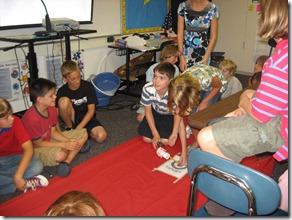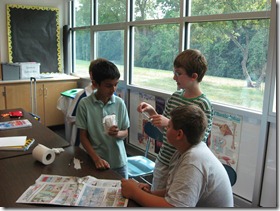Building positive group work ethics in project-based learning
Can you think of a job or profession that is done alone? No co-workers to consult, no team responsible for contributing different pieces of a project, no meetings (well, maybe that might be okay ; )
It’s hard to come up with many. Artist? Author? (at least during the initial writing process). We could probably come up with a few more, but the list is relatively short. Working in teams, collaborating with others in our work and life is fundamental. Not only do we gain social benefits, but the ability to combine the strengths of a team most often leads to a better end result.
Though we’ve all heard that initial reaction from students as a group project is introduced: ‘Can we pick our own groups?’ or even worse, ‘Do I have to be with him/her?’ The skills of working effectively in groups need to be coached, practiced and encouraged. So when you see reflective comments such as these (from real students) it is encouraging:
“A good team looks like a team that is on task, getting along and sharing.” (5th grade)
“A good team looks like a friendly team with members working together. I have learned practical skills that will help me get a job.” (5th grade)
“A good team looks and sounds like they are working together, improvising, compromising, discussing ideas calmly and working out disagreements.” (6th grade)
“In the real world you may have to work with people you do not like and you need to know how to still be productive.” (6th grade)
So how did these students get here?
Pauline Roberts, a 5th and 6th grade teacher at the Birmingham Covington School in Bloomfield Hills, MI has made developing these skills a priority. The unique program she and her colleagues have collaborated on at this 3rd – 8th grade public school is called ENGAGE. The focus is to embed 21st century skills across multiple grades and all parts of the curriculum with a specific emphasis on problem and project-based learning. One of the key elements that sets this program apart is its emphasis on working effectively in teams.
The ENGAGE program focuses on Digital Age Literacy, Inventive Thinking, Effective Communication and High Productivity while encompassing science, technology education, mathematics and language arts. Ms. Roberts points out that the ENGAGE program was specifically designed to not focus on curriculum delivery. The goal was to secure optimal engagement of the students. 
The projects students take on inevitably make links to curriculum (and beyond), for example, in using Pico Crickets students must explore energy transformations. When making digital stories students consider plot, language and effective writing using Microsoft Word. For digital labs the students choose a science experiment and instead of writing it up in a traditional lab format they make them digital. For stop & go animations using tools like Movie Maker and PhotoStory, the students are given the theme of “Kids can make a difference,” which led to big idea explorations like saving the environment, addressing world poverty, hunger and bullying. The Building Big project includes geometry principles as students investigate the properties of various shapes while the flight unit requires investigation of aerodynamics. The problem posed takes precedent while the curriculum is embedded into the project.
Each ENGAGE project is designed as a standalone unit lasting 2-3 weeks each quarter and students work in teams to take on the challenge posed for that unit. The deep learning happens with emphasis and coaching on how to work well in groups.
In Ms. Roberts’ words: “Before we taught Engage, students really struggled to work together and many had the “my way or the highway” approach, so much so that previous teachers would give in and let those students work alone. Realizing that this was a big problem we have worked extremely hard to train our students how to reach consensus, how to be politely critical, how to advocate for their own ideas and most importantly how to listen to each other’s ideas. By developing these skills my students have become increasingly productive, efficient and creative as they really know how to identify each other’s strengths and weaknesses, manage themselves  and work together to find the optimum solutions to the challenges they are presented with.”
and work together to find the optimum solutions to the challenges they are presented with.”
This is the type of learning that builds experiences and skills that will serve students beyond their elementary and middle school years. You can see the full scope and sequence of project ENGAGE including project ideas on the ENGAGE wiki maintained by multiple educators involved in this program that crosses all grades and subjects.
Pauline Roberts is not new to acknowledgements for her work, as she was highlighted as Teacher of the Year in her community, though she is quick to point out the cross school collaboration that goes into developing and maintaining this program.
Ms. Roberts will join 10 other educators representing the U.S. at the Microsoft Partners in Learning 2011 Global Forum Nov. 7-11 in Washington, DC. The forum focuses on showcasing and highlighting innovative education practices from around the world and is the culmination of a series of regional events that happen across the globe.
You can learn more about the Global Forum on our Facebook page. I will also be following the event live @TeachTec so keep an eye out for #PiLGF.
Regards,
Rob